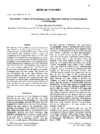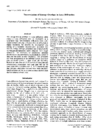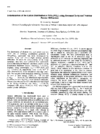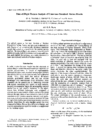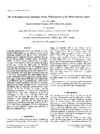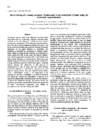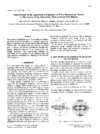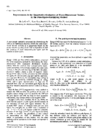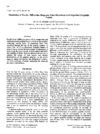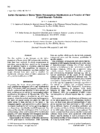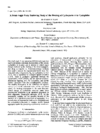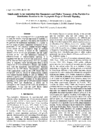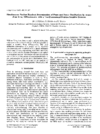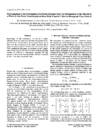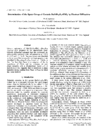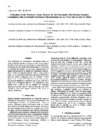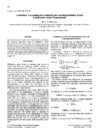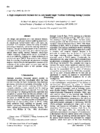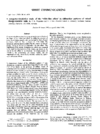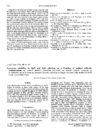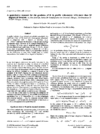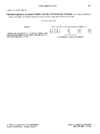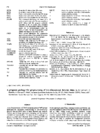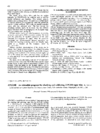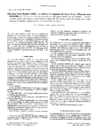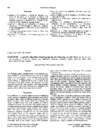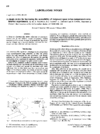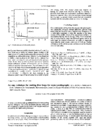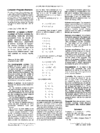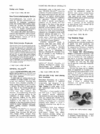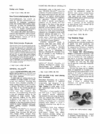issue contents
October 1995 issue

Cover illustration: The observed X-ray diffuse scattering in the (h0l) section of 1,3-dibromo-2,5-diethyl-4,6-dimethylbenzene. Courtesy of T. R. Welberry and B. D. Butler.
research papers
Accurate and complete structure-factor amplitudes can be obtained from synchrotron Laue diffraction patterns by a series of novel approaches to Laue pattern integration and data scaling.
Energy overlaps in Laue diffraction can be resolved to yield complete and accurate sets of structure-factor amplitudes even at very low resolution.
The distribution of divalent iron and nickel over two metal sites in the solid solution NiFe2(PO4)2, sarcopside, has been investigated by resonant X-ray and time-of-flight neutron powder diffraction. The appropirate value of f' for iron was measured by diffraction from a chemically similar compound, Fe3(PO4)2.
The texture of a deformed limestone sample has been investigated by neutron time-of-flight diffraction. The results obtained are compared with the results from other facilities for the same sample.
The coefficient of thermal expansion and lattice structure of (Sr1-x, K2x)Zr4(PO4)6 ceramic have been characterized using a dilatometer and a high-temperature X-ray diffractometer.
A Debye-Scherrer powder camera, with image plates instead of film, has been installed on a synchrotron source. Its performance has been tested with data taken over a range of wavelengths from a rutile specimen.
A new method of directly fitting combinations of X-ray and neutron grazing-incidence reflection profiles based on the kinematic approximation is described, demonstrated and compared with existing methods.
The evaluation of three-dimensional orientation distribution functions from two-dimensional pole figures is re-examined. A practical relationship between pole-figure accuracy and the number of useful pole figures is determined.
A new simple method is proposed for determination of the orientation distribution function of texture analysis.
X-ray diffraction patterns from distorted graphitic particles and finite honeycomb carbon layers are calculated using the Debye equation and real-space models of atomic arrangements.
The fundamental reference values of lattice parameters for all crystalline modifications of BN have been established.
The small-angle X-ray scattering technique has been used to investigate structural characteristics in solution of (i) the protein cyclophilin and (ii) the cyclosporin-A/cyclophilin complex. Results indicate that cyclophilin has a compact spherical shape with a radius of gyration of 16.3 Å.
A method is presented that allows the applicability of the Lifshitz-Slyozov-Wagner theory of Ostwald ripening to be proved for phase-separating systems. The method is based on experimental SAXS data that characterize the size-distribution type established.
A diffractometer system with an area detector and a suitable Soller plate collimator allows efficient position-resolved and visualized phase and stress analysis simultaneously for a sample straight line in the centimetre scale. The principal application possibilities are demonstrated with examples.
Oblique and symmetric Bragg reflections can in some cases (e.g. 220 from germanium) be mixed in a channel-cut monochromator without loss of intensity.
From the orientation of three differently oriented alpha plates inherited from the b.c.c.-h.c.p. phase transformation, it is possible to determine the orientation of the parent β grain.
Ceramic specimens of BaO.Pr2O3.4TiO2 were prepared by a classical mixed-oxide route. Transmission-electron-microscope electron diffraction studies showed that the dielectric has orthorhombic symmetry with the space group Pnam, one of the two possible space groups previously identified for Ba3.75Ln9.5Ti18O54.
The calculation of characteristics describing the texture as well as relations between orientations and morphological features of the microstructure are based on single orientation measurements. For such experimental data, it is essential to estimate the number of necessary measurements of single orientations for a statistically significant representation of the investigated quantity, which in the present paper is the orientation distribution function.
Two corrections are made to equations for estimating counting-statistical errors in diffraction stress measurements and compared to a Monte Carlo simulation.
Cu(OH)2 is predicted to be ferroelectric on the basis of its recently redetermined crystal structure. Calorimetric and dielectric permittivity measurements have verified the prediction, with the predicted Tc = 343 K and the measured Curie temperature in the range 325-335 K.
The orthorhombic low-temperature form of ferromagnetic NaV6O11 (TC = 64.2 K) is found to crystallize in the noncentrosymmetric space group Cmc21 with no superstructure by an X-ray single-crystal diffraction study performed at 300, 100 and 20 K.
The design and operation of a new small-angle neutron scattering furnace are presented. An example drawn from a kinetic study of materials processing is given.
short communications
Computer simulations have been carried out which confirm that the unusual diffraction effect known as the `white-line effect', which is observed in diffraction patterns of some mixed charge-transfer salts, is caused by the pinning of charge-density waves to defects.
Results showing increased solubility of lysozyme in H2O compared to D2O are presented.
The novel quality indicator Nσ exhibits the significance level of the result of a least-squares refinement, independent of the number ν of degrees of freedom. For all ν > 20, |Nσ| < 3 indicates conformity of data, weights and model.
In situ X-ray diffraction is applied on-line to optimize crystallization conditions for the preparation of a pharmaceutical compound.
Correction to J. Appl. Cryst. (1995). 28, 306-313.
computer programs
EDPDB is a multifunctional computer program for the analysis of protein structures, both individually and in crystals.
A program package for interactive preprocessing of two-dimensional detector data has been developed based on CERN's program package PAW. The main use of the package is in analyzing X-ray small-and wide-angle scattering data.
The program XPLCHK aids adaptation or development of new X-PLOR input files by scanning these files for common errors and listing parameter assignments.
A Laue Data Module (LDM) and related functions have been defined and implemented in Fortran for use in the initial stages of Laue X-ray diffraction data processing.
A genetic algorithm-based program indexes crystal planes using a set of interplanar angles.
Real-time powder diffraction studies at the Daresbury Laboratory Synchrotron Radiation Source produce many hundreds of powder diffraction patterns every day. Computer programs have been developed for the automatic reduction of these patterns to lists of peak parameters using both multiple peak fitting to selected ranges of each pattern and full pattern fitting.
laboratory notes
A device is described for the collection of oscillation-method data in two different orientations of a cryostat-mounted sample crystal.
High-resolution powder diffraction has been applied in this study of wax material close to 273 K. Details of the cell construction are given.
A versatile system for making calibrated loops for cryo-cooling has been designed.
fast communications
Darwin's parameter Y defined on the dispersion surface and the associated deviation parameter ηY given by the Takagi-Taupin equations are proposed to characterize the angular deviation from the exact resonance of Bragg diffraction.
computer program abstracts
An update to PARST, PARST95, is presented.
notes and news
Free 

new commercial products
Free 



 journal menu
journal menu









